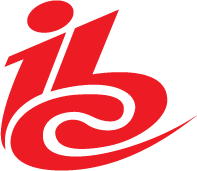
The International Broadcasting Conference is being held in Amsterdam this week, which brings with it a variety of exciting announcements and new products. I do not travel to Europe for the show, but I do keep an eye on the various news and updates that happen there. These are just a few of the ones that stood out to me the most, or are relevant to my projects and workflows.
Adobe Premiere Pro 25.5 has been released, which includes a whole new collection of artistic effects for video and motion graphics within Premiere Pro. These are the result of Adobe’s recent acquisition of Film Impact, makers of a wide variety of accelerated transitions and effects for Premiere Pro, which used to require a separate subscription, but are now integrated directly into the application for all existing users. One interesting unique function, which was in Film Impact’s existing implementation, is the ‘Surprise Me’ button, which randomly sets the input variables. This allows users to rapidly generate a variety of unexpected artistic effects, but this is primarily useful if you don’t know what you want. So for a certain type of creative experimentation it can be an intriguing option.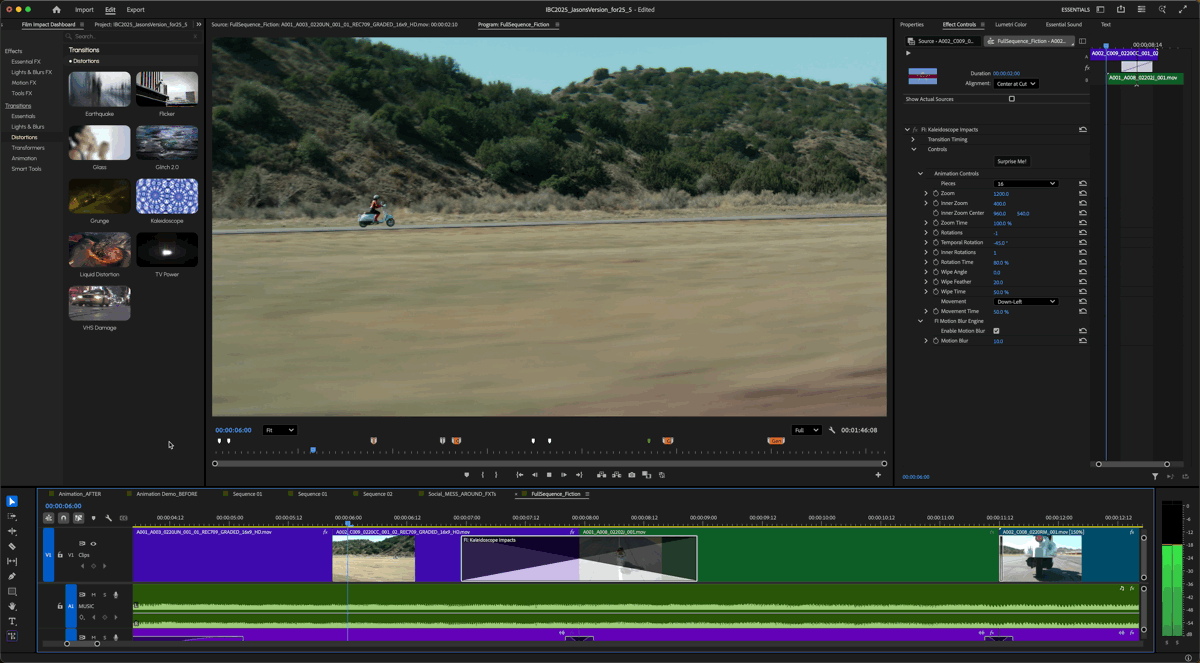
Adobe has also announced a version of Premiere Pro for iPhone coming at the end of the month, and shared that a version for Android is in the works. This is probably great for a lot of people, but I have next to no interest in producing content on my cell phone. I am a very precise and deliberate person, so I create content on large displays where I can get exactly what I want, not on a tiny cell phone screen with limited and automated options. But obviously it has its place, and the ease of creating content can lower certain mental barriers and promote creativity, at the expense of also generating a lot of useless garbage.
 AJA has announced a couple of new products at the show, including the IP25-R which is an IP video interface, converting SMPTE 2110 from 25GbE networks to feeds to SDI and HDMI based infrastructure. I ‘get’ the idea behind IP video, but mixing it with traditional solutions and products is very expensive, as reflected in the $4K price tag for this convertor. This connects to an even more expensive data switch, due to the bandwidth required for the uncompressed data. NDI seems like a much better approach to IP video, but it is possible the JPEG-XS will bring that type of capability to the ‘professional’ world. That dream appears it could be coming together in the form of AJA’s even more expensive Bridge Live 12G-4, which is a multi-channel bidirectional IP video interface, with support for NDI, JPEG-XS, J2K, HEVC, and a variety of other compression standards and formats, now up to 4K in resolution. I am just waiting for the price to come down for these new IP Video capabilities, which was supposed to be the main benefit in the first place, but it is taking a while to reach that point. AJA also released the UDC-4K, which is an Up/Down/Cross Converter for 4K signals in SDI and HDMI, but it seems exactly like a Decimator 12G box for three times the price. Being a company that is local to me, I want them to succeed, but the last product they released that I was impressed with was the T-Tap Pro, a few years ago.
AJA has announced a couple of new products at the show, including the IP25-R which is an IP video interface, converting SMPTE 2110 from 25GbE networks to feeds to SDI and HDMI based infrastructure. I ‘get’ the idea behind IP video, but mixing it with traditional solutions and products is very expensive, as reflected in the $4K price tag for this convertor. This connects to an even more expensive data switch, due to the bandwidth required for the uncompressed data. NDI seems like a much better approach to IP video, but it is possible the JPEG-XS will bring that type of capability to the ‘professional’ world. That dream appears it could be coming together in the form of AJA’s even more expensive Bridge Live 12G-4, which is a multi-channel bidirectional IP video interface, with support for NDI, JPEG-XS, J2K, HEVC, and a variety of other compression standards and formats, now up to 4K in resolution. I am just waiting for the price to come down for these new IP Video capabilities, which was supposed to be the main benefit in the first place, but it is taking a while to reach that point. AJA also released the UDC-4K, which is an Up/Down/Cross Converter for 4K signals in SDI and HDMI, but it seems exactly like a Decimator 12G box for three times the price. Being a company that is local to me, I want them to succeed, but the last product they released that I was impressed with was the T-Tap Pro, a few years ago.
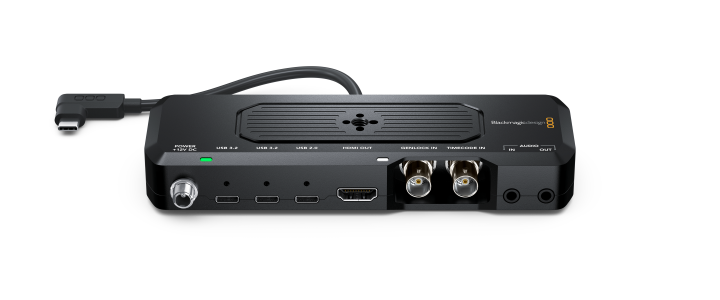 The Blackmagic Camera ProDock is a $300 accessory for the new iPhone 17, which adds professional I/O options for Shot on iPhone workflows. This is hardware to go with their existing software, Blackmagic Camera for iOS. I have one annual project that has been shifting towards Shot on iPhone, and this device will almost certainly aid our workflow, as we try to integrate the iPhone into a larger traditional production workflow. It offers Genlock and Timecode input, and HDMI output, as well as audio in and out, and USB recording drive support. It is kind of shocking that it doesn’t offer SDI output, although that can be adapted from HDMI when needed. But the HDMI output on the iPhone 16 was very picky about output options, and needed to be ‘tricked’ into offering the optimal formats and frame rates. Hopefully this will not have the same limitations. Another result of closer collaboration between Apple and Blackmagic Design is new ProRes RAW support in Resolve and BlackMagic Camera.
The Blackmagic Camera ProDock is a $300 accessory for the new iPhone 17, which adds professional I/O options for Shot on iPhone workflows. This is hardware to go with their existing software, Blackmagic Camera for iOS. I have one annual project that has been shifting towards Shot on iPhone, and this device will almost certainly aid our workflow, as we try to integrate the iPhone into a larger traditional production workflow. It offers Genlock and Timecode input, and HDMI output, as well as audio in and out, and USB recording drive support. It is kind of shocking that it doesn’t offer SDI output, although that can be adapted from HDMI when needed. But the HDMI output on the iPhone 16 was very picky about output options, and needed to be ‘tricked’ into offering the optimal formats and frame rates. Hopefully this will not have the same limitations. Another result of closer collaboration between Apple and Blackmagic Design is new ProRes RAW support in Resolve and BlackMagic Camera.
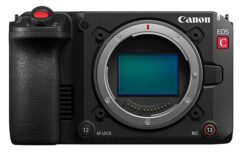 Canon has announced the EOS C50, as a compact full frame cinema camera. It apparently replaces the R5C as a full frame mirrorless camera, but sits below the C70 and C80 in the Cinema EOS lineup, at least numerically. With a 7K full frame sensor, it appears to outclass the C70 by every measure. The C80 offers SDI output and a few other high end features, but Canon has really raised the bar on the lower end of their Cinema lineup. The C50 can record 7Kp60 to Cinema RAW, and 4Kp120 to XF-AVC, as well as recording multiple aspect ratios to separate formats and cards, and integrates directly with FrameIO’s Camera to Cloud functionality. It has an RF lens mount, which can also be adapted to PL lenses. Canon also released a new 85mm F1.4 L-series Lens, and a new wide zoom CineServo lens. They also announced a new EPLH 360 camera, in response to a resurgence in popularity of ‘old-school’ point and shoot cameras. It maintains the 12x zoom and 20Megapixel sensor of the original Powershot 360, surprisingly including a USB mini jack instead of USB-C, but does move to Micro SD cards to save space. Kind of the opposite of the Shot on iPhone trend that Blackmagic and Apple are leaning into.
Canon has announced the EOS C50, as a compact full frame cinema camera. It apparently replaces the R5C as a full frame mirrorless camera, but sits below the C70 and C80 in the Cinema EOS lineup, at least numerically. With a 7K full frame sensor, it appears to outclass the C70 by every measure. The C80 offers SDI output and a few other high end features, but Canon has really raised the bar on the lower end of their Cinema lineup. The C50 can record 7Kp60 to Cinema RAW, and 4Kp120 to XF-AVC, as well as recording multiple aspect ratios to separate formats and cards, and integrates directly with FrameIO’s Camera to Cloud functionality. It has an RF lens mount, which can also be adapted to PL lenses. Canon also released a new 85mm F1.4 L-series Lens, and a new wide zoom CineServo lens. They also announced a new EPLH 360 camera, in response to a resurgence in popularity of ‘old-school’ point and shoot cameras. It maintains the 12x zoom and 20Megapixel sensor of the original Powershot 360, surprisingly including a USB mini jack instead of USB-C, but does move to Micro SD cards to save space. Kind of the opposite of the Shot on iPhone trend that Blackmagic and Apple are leaning into.
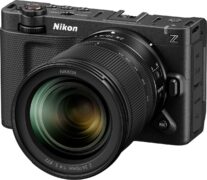 Nikon just released their first new camera since their acquisition of RED Camera last year. The Nikon ZR is another compact full frame Cinema Camera. It has a 6K sensor, and can record 12bit RedCode RAW, Nikon’s N-RAW, or ProRes RAW to CFexpress cards, as well as H.265 to MicroSD cards for proxies. Shooting in the new 12bit RedCode RAW “NE” (Normal efficiency) format allows recording in Log3G10 and REDWideGamutRGB, but this new 12bit flavor of R3D is not backward compatible with existing R3D decoding, so explicit software support will be required for those files to be used in post. Speaking of post, the ZR has Frame.IO C2C integration for rapid turnaround workflows. It uses Nikon’s mirrorless Z-Mount, which can be adapted to many other lenses. It has MicroHDMI output, and 32bit float audio recording, but no XLR inputs. It also lacks anamorphic desqueeze, which could be added in a firmware update in the future. At nearly half the price of Canon and Sony’s offerings, it could be a compelling option for anyone familiar with Red workflows.
Nikon just released their first new camera since their acquisition of RED Camera last year. The Nikon ZR is another compact full frame Cinema Camera. It has a 6K sensor, and can record 12bit RedCode RAW, Nikon’s N-RAW, or ProRes RAW to CFexpress cards, as well as H.265 to MicroSD cards for proxies. Shooting in the new 12bit RedCode RAW “NE” (Normal efficiency) format allows recording in Log3G10 and REDWideGamutRGB, but this new 12bit flavor of R3D is not backward compatible with existing R3D decoding, so explicit software support will be required for those files to be used in post. Speaking of post, the ZR has Frame.IO C2C integration for rapid turnaround workflows. It uses Nikon’s mirrorless Z-Mount, which can be adapted to many other lenses. It has MicroHDMI output, and 32bit float audio recording, but no XLR inputs. It also lacks anamorphic desqueeze, which could be added in a firmware update in the future. At nearly half the price of Canon and Sony’s offerings, it could be a compelling option for anyone familiar with Red workflows.
These new compact full frame cinema cameras invite comparison to the existing options, in the form of Sony’s FX3 and BMD’s Cinema Camera. They all have approximately 36mm x 24mm full frame sensors, and record to CFexpress cards. They all have USB-C ports for connectivity and expansion. But beyond that, they all have widely varying features and options:
| Camera | Canon C50 | Nikon ZR | Sony FX3 | BMD Cinema |
| Resolutions | 7Kp60, 4Kp120 | 6Kp60, 4Kp120 | 4Kp120 | 6Kp36, 4Kp60, HDp120 |
| Record Formats | C-RAW, XF-AVC/HEVC-S | R3D, N-RAW, ProRes, H265, H264 | RAW (External) XAVC | B-RAW, H264 |
| Media | CFexpress, SD | CFexpress, MicroSD | CFexpress, SD | CFexpress |
| Lens Mount | RF Mount | Z-Mount | E-Mount | L-Mount |
| Anamorphic Desqueeze | Yes | No | Yes | Yes |
| XLR Input | Yes | No | Yes | Yes |
| FrameIO C2C | Yes | Yes | No | No |
| Price | $3900 | $2200 | $4100 | $3100 |
Anyhow, compact cinema cameras and IP video seem to be trends of the moment at this year’s show, and I look forward to seeing the downstream impacts of these innovations on post workflows. I like Red’s color science workflow, so a $2000 camera that records files in their R3D codec can only lead to more projects in that format. And eventually IP Video will simplify workflows, but the ecosystem has not matured to that point yet. So we will just have to keep looking for new products to further refine those options.
